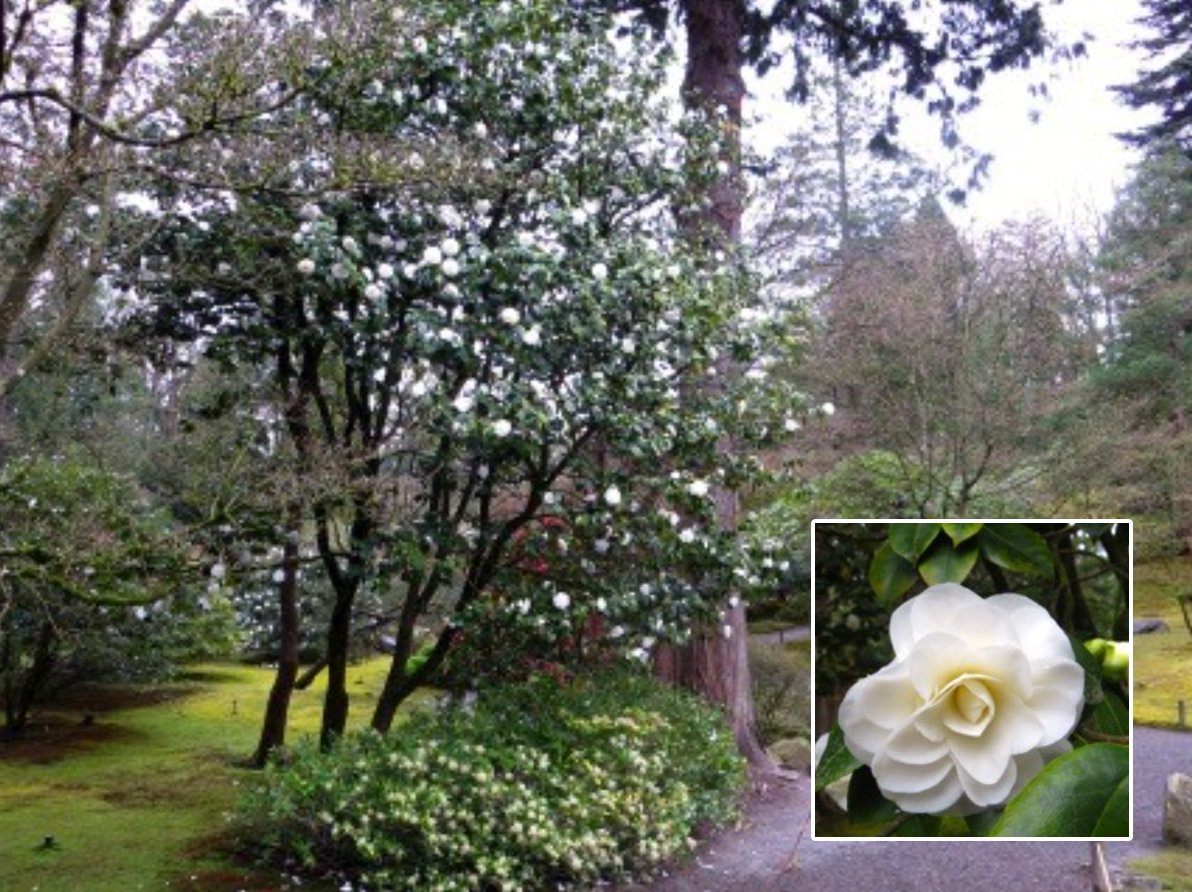Camellia Collection
Plant Area Map — Camellia Collection
About Camellia
Camellia・ツバキ・椿 / tsubaki is a genus of flowering plants that are members of the tea family, Theaceae. Native to eastern and southern Asia, from the Himalayas to Japan and Indonesia camellia comprise 100–300 described species. Linnaeus named the genus after the Jesuit botanist Georg Joseph Kamel, who worked in the Philippines and described a species of camellia.
Camellias were cultivated in the gardens of China and Japan for centuries before they were seen in Europe in 18th century. The German botanist Engelbert Kaempfer wrote that the "Japan Rose", as he called it, grew wild in forests and thickets, but that many superior varieties had been selected for gardens. He was told that the plant had 900 names in Japanese.
In our climate they bring blossoms during the cold months. Our Garden has 32 different camellias, 23 of them Camellia japonica, which are in a beautiful profusion of bloom in the time of the Garden opening at the end of winter each year and continue to flower for several weeks. We also have Camellia sinensis that is processed for the tea beverage in Asia and India, Camellia oleifera, which produces tea seed oil used in cooking and cosmetics, and Camellia sasanqua, which is the first to bloom from late fall through early winter.
Camellia japonica ‘Purity’
Area D, above the white and red-fruited Skimmia shrubs
‘Purity’ has medium-sized, pure white flowers, as its name indicates. The flower form is formal double, sometimes called rose-form.
The delicate camellia ‘Purity’ is vigorous, compact and has an upright to spreading habit. Its formal double blooms are large, snowy white and appear mid-season (late winter). They have a gardenia-like shape with lots of rows of overlapping petals. Slow growing, upright to spreading shrub or small tree with age.
This is an ancient cultivar from Japan, ‘Shiragiku,’ that originated in 1681.
Camellia japonica ‘Purity’, Area D, above the white and red-fruited Skimmia shrubs
Camellia japonica ‘Finlandia’
NW corner Area B, best seen along the path to the service road
‘Finlandia’ has medium to large, pure white, semi-double flowers, often with reddish-pink stripes or spots. The fluted petals are swirled around the center, with its contrasting yellow stamens. It blooms early to mid-season. Evergreen with glossy foliage. It was registered in the U.S. in 1941, as a sport of ‘Finlandia Variegated.’ Synonyms are ‘Finlandia Alba,’ and ‘White Jordan.’
Camellia japonica ‘Finlandia’, NW corner Area B, best seen along the path to the service road
Camellia japonica ‘Amabilis’
Area C, not far from the entrance gate, near the east fence
‘Amabilis’ means worth of love, and this camellia is lovely in its simplicity. It has large, single white flowers with many long white filaments and yellow stamens. It was introduced in Japan as ‘Yukimi Guruma,’, which means Snow Viewing Carriage. It was introduced in the U.S.in 1932, and given the name ‘Amabilis.’ In the U.K., it’s grown by the name ‘White Swan.’
Camellia japonica “Amabilis’, Area C, not far from the entrance gate, near the east fence
Camellia japonica ‘Cheerful’
Area C, first of the two red camellias behind and right of the Red Laceleaf Japanese Maple
‘Cheerful’ has small, fully double, deep pink flowers, opening in February or March. Its center holds tightly until the flower is fully open. It was developed by S. Quin, of Mississippi, about 1883.
Camellia japonica “Cheerful’, Area C, first of the two red camellias behind and right of the Red Laceleaf Japanese Maple
Camellia japonica ‘Hikaru-Genji’
Area C, second of the two red camellias behind and left of the Red Laceleaf Japanese Maple
This ancient Japanese cultivar, first recorded in 1859, is a mid-season bloomer. It has medium-sized, fragrant, peony-form flowers. Delicately colored, they’re red-pink with white edges and streaks, and deeper crimson veining. The leaves are narrower and more pointed than those of most Camellia japonica cultivars. Synonyms used in the West, are ‘Herme’ and ‘Jordan’s Pride.’
Camellia japonica ‘Hikaru-Genji’, Area C, second of the two red camellias behind and left of the Red Laceleaf Japanese Maple
Camellia japonica ‘Lily Pons’
Area C, NE of the lantern, between dry riverbed and fence
With large single to semi-double white flowers, this elegant bloomer resembles a water-lily. ‘Lily Pons’ originated in the U.S. in 1955, and was received by the Washington Park Arboretum from Barney Goletto, of Milwaukee, Oregon.
Camellia japonica ‘Lily Pons’, Area C, NE of the lantern, between dry riverbed and fence
Camellia japonica ‘Daikagura’
Area C, next to the Western Red Cedar, where the path bends
An ancient Japanese cultivar, this is a very early-bloomer, with peony-form flowers. Its large, bright rose-red flowers are blotched white. Registered in Japan in 1891, ‘Daikagura’ originated much earlier. It’s considered one of the greatest Camellias of all time, and has been planted in parks and botanic gardens around the world. Historically, the word Daikagura comes from Kagura, a sacred dance performed in the imperial court, one of the oldest dances of Japan. Kagura evolved in many different directions, including Daikagura, a festive, popular form. Performed by traveling dancers, it included lion dances, acrobatics and juggling.
Camellia ‘Daikagura’, Area C, next to the Western Red Cedar, where the path bends
January 2022 • This handout was inspired by the posters of plants prepared by docent Kathleen Smith, who for 20 years singlehandedly created and maintained our Plant List, and many educational materials, before her death in 2011. Aleksandra Monk, Corinne Kennedy & Kathy Lantz @ SJG docent Plant Committee.












